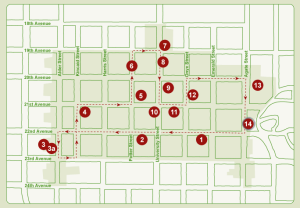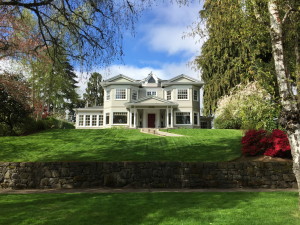The City of Eugene was formally incorporated as a city in 1862, but was not actually named Eugene until 1889. In 1872 the state determined the Eugene would be the home of the University of Oregon but it had no money to purchase land or build. The residents of Eugene struggled to help finance the institution by holding numerous festivals, church socials, and produce sales. They raised $27,500 to buy eighteen acres of farmland. The University of Oregon was finally establish at it’s current site in 1876 with the land purchase and the construction of it’s sole building, Deady Hall.
As the city population grew, and the University of Oregon began to grow attracting professors, and professionals, the tract of farmland just south of the University was eyed by a group of early developers who projected the area would be an ideal residential site for family homes. The promise by the city to extend a street car service down University street to 24th sealed the deal. Calling themselves the Lane County Investment Company, the developers purchased the land from Alder Street to Agate on east, and 18th Ave to 23rd on the south side from $24,000 on January 16, 1907 and divided the land into plots which originally sold at $30 to $50 each. This early development was known as “Gross’s Addition”. The original developers were named FW Osburn, TW Harris, GG Gross, AC Woodcock, and EO Potter. Today the neighborhood retains the names Potter and Harris as street names.
The development started slowly in the beginning due to frequent flooding on the streets lower on the hill and the initial slow growth of the UO. Earliest photos of the South University Neighborhood, ca. 1910, show only a few scattered farmhouses. Even as late as the 1920’s, University street, the street at the highest elevation with the promised street car service in place since 1907, was largely undeveloped. There were likely several factors that finally prompted construction of many homes. First, was a spate of construction on the University Campus including Hayward Field, Johnson Hall and several academic buildings in 1919, and McArthur Court in 1926. But it was the construction of Edison Elementary School in 1926 which spurred the most growth in home building. it was said at the time that Edison School was the “drawing card” for the neighborhood. Designed by Theodore Gerow, a neighborhood architect who also designed at least two other houses in the South University Neighborhood.
The residences on University street are set back from the street and sidewalks due to early building restrictions. This resulted in wide, well manicured lawns which contribute to the park-like landscaping we see today.
Most of the trees planted originally were European Birch with some Cratagus. These were favored by an early popular builder, Prescott, who planted them with an overarching view of Parisian streets in mind. Many suffered from occasional ice storms and the wild Columbus Day storm of 1962. Other older planted by residents species include Liquidambar, Dogwood, Gingo, Flowing Plum, Pin Oak, and Red Maple.
During the development period of the South University Neighborhood, it was common for a builder to purchase multiple lots on a block and build several of the houses on that block, filling in other lots with houses purchased from 11th or 13th Avenues (which were changing from residential to commercial zoning) and moved to the SUN. There are many examples of “traveled” houses.
Every house in the neighborhood has a story to tell. Many of Eugene’s most beloved characters and luminaries have lived and raised families in these homes. There have always been professors, deans, presidents of the University of Oregon, attorneys, judges, doctors, dentists, business leaders, public officials, realtors, architects and artists. Residents have contributed to Eugene’s economic, political, and intellectual fabric. Several state and National leaders and luminaries have also been raised in the homes of the South University Neighborhood.
There have been multiple failed attempts to have the City of Eugene recognize the South University Neighborhood as a National Historic registered neighborhood starting in 1973 with the formation of the South University Neighborhood Association (SUNA). Ironically the success of the University of Oregon, which was part of the initial catalyst for the neighborhood growth, may be the reason the neighborhood declines and a beautiful walkable family residential neighborhood. The combination of the failure of historic designation and the significant growth of the University of Oregon without building student housing to keep pace has lead to many historic single family homes being sold as student rentals beginning in the early twenty-first century. Today the University of Oregon, City officials and the member of SUNA are working together to protect and preserve the historic nature of one of Eugene’s most valued neighborhoods.
This walking tour through the streets of SUNA is a great way to connect with our neighbors, past and present. Print out the map or take it with you on your smart phone. Be sure to say hello to neighbors your meet along the way, maybe you’ll learn more than the stories outlined here.
Leading Architects include: Pietro Belluschi, WRB Willcox, John Hunziker, Theodore M. Gerow, Wallace s. Hayden, Francis Benedict Jacoberger, Margaret Fritsch, and John Laurin Reynolds. Remodeling projects include the work of Otto Poticha, DeNorval Unthank, Daniel, Herbert, Dan Childress and Leslie Childress-Ullman.
1. Edison School 1328 East 22nd
2. Clarence V. Boyer House 1138 East 22nd
3. Thurston Hall & Humbert Hall 2288 & 2244 Alder
4. James Scott McMurray House 930 East 21st
5. E.D. Southmayd House 2089 Potter
6. Potter & University Streetscapes
7. Old Delta Tau Delta Fraternity 1883 University
8. Street Car Tracks
9. Carl Smith House 2015 Unversity
10. J.F. & Susy Gerot House 2114 University
11. Ray & Mary Glass House 1256 East 21st
12. Classic Craftsman: 2077 Onyx
13. Washburne Park East side of Agate Street
14. William B. Baker House 2175 Agate


